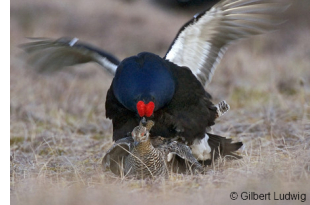The black grouse mating system: lekking
In spring time (late April to early May), male black grouse gather in open areas such as bogs, clearcuts or even on frozen lakes, to defend small territories. Female's visit then these clusters of territories (called a lek) solely to mate. Males show a number of behaviours on leks. These include rookoing, hissing and fighting. To listen to the sounds of a lek, click here.

Females choose the most viable male based a number of morphological and behavioural cues (Rintamäki et al. 2001). Males who fight frequently, at the centre of leks are most frequently the dominant indivuduals who acquire most of the matings (Alatalo et al. 1991; Hovi et al. 1994). Sexual ornaments such as lyre tail length (Höglund et al. 1997), blue colouration of breast feathers (Siitari et al. 2007) and eye comb size (Alatalo et al. 2006b) all show different components of male quality and are used as additional information by females to choose a high-quality mate.
Male cannot force females to mate. Instead females visit leks over a number of days, before choosing a single male to mate with. Copulations are usually short (a few seconds) and female's normally mate once and one male generally sires the whole brood (Lebigre et al. 2007). Females prefer to attend large leks as this increase's the ability to identify a high quality mate (Alatalo et al. 1992, 1996a).
 Not all males will mate and normally one male will acquire a large proportion of matings. Most matings are acquired by males aged between 3 and 5 year old. These top males are typically found at the centre of leks where they have the highest rates of fighting. The mating skew varies between sites and years, but can be as high as 90%.
Not all males will mate and normally one male will acquire a large proportion of matings. Most matings are acquired by males aged between 3 and 5 year old. These top males are typically found at the centre of leks where they have the highest rates of fighting. The mating skew varies between sites and years, but can be as high as 90%.
Autumn leks
Males also gather in the autumn to lek. At this time, females may also attend leks and it is thought that females use this as an early opportunity to assess male quality (Rintamäki et al. 1999). Post-spring lekking mortality is high in males (i.e. in summer), so lekking provides an early opportunity for males to fill vacated dominant positions that they then maintain through the the next spring's lek.
References
Alatalo, R.V., Burke, T., Dann, J., Hanotte, O., Höglund, J., Lundberg, A., Moss, R. & Rintamäki, P.T. (1996a) Paternity, copulation disturbance and female choice in lekking black grouse. Animal Behaviour, 52, 861-873.
Alatalo, R.V., Höglund, J., Lundberg, A., Rintamäki, P.T. & Silverin, B. (1996b) Testosterone and male mating success on the black grouse leks. Proceedings of the Royal Society B: Biological Sciences, 263, 1697-1702.
Alatalo, R.V., Höglund, J. & Lundberg, A. (1991) Lekking in the black grouse-a test of male viability. Nature, 352, 155-156.
Alatalo, R.V., Höglund, J. & Sutherland, W.J. (1992) Evolution of black grouse leks: female preferences benefit males in larger leks. Behavioral Ecology, 3, 53-59
Höglund, J., Johansson, T. & Pelabon, C. (1997) Behaviourally mediated sexual selection: characteristics of successful male black grouse. Animal Behaviour, 54, 255-264.
Hovi, M., Alatalo, R.V., Höglund, J., Lundberg, A. & Rintamäki, P.T. (1994) Lek center attracts black grouse females. Proceedings of the Royal Society B: Biological Sciences, 258, 303-305
Lebigre, C., Alatalo, R.V., Siitari, H. & Parri, S. (2007) Restrictive mating by females on black grouse leks. Molecular Ecology, 16, 4380-4289.
Rintamäki P.T., Karvonen E., Alatalo R.V., & Lundberg A. (1999) Why do black grouse males perform on lek sites outside the breeding season?. Journal of Avian Biology, 30, 359–366.
Rintamäki, P.T., Alatalo, R.V., Höglund, J. & Lundberg A. (2001) Correlates of male mating success on black grouse (Tetrao tetrix L.) leks. Annales Zoologica Fennici, 38,: 99-109.
Siitari, H., Alatalo, R.V., Halme, P., Buchanan, K.L. & Kilpimaa, J. (2007) Color signals in the black grouse (Tetrao tetrix): signal properties and their condition dependency. American Naturalist, 169, supplement 81-92.


